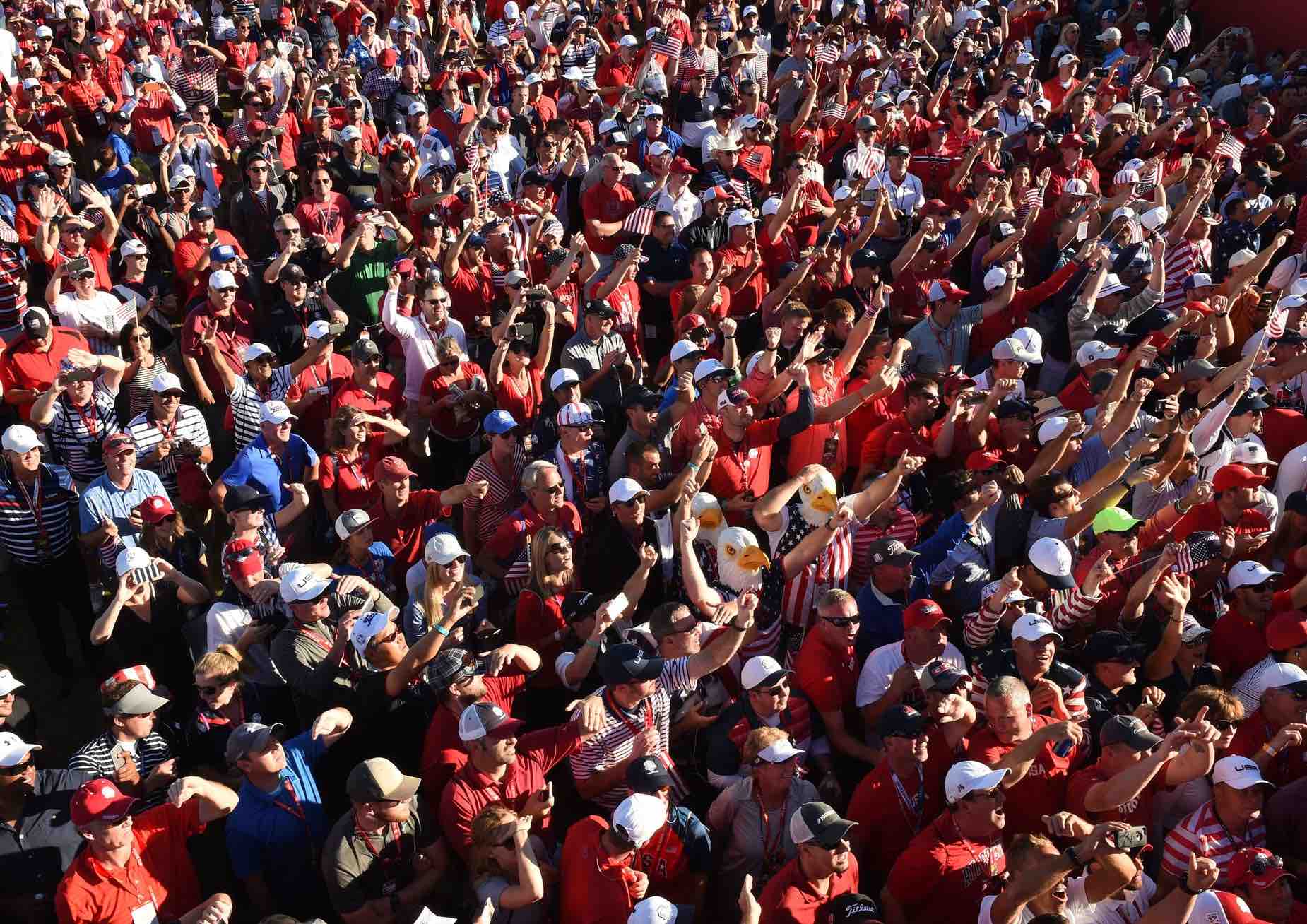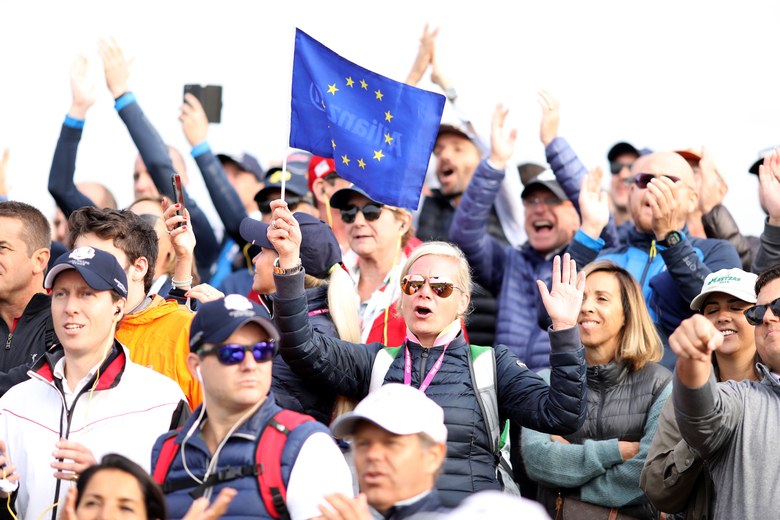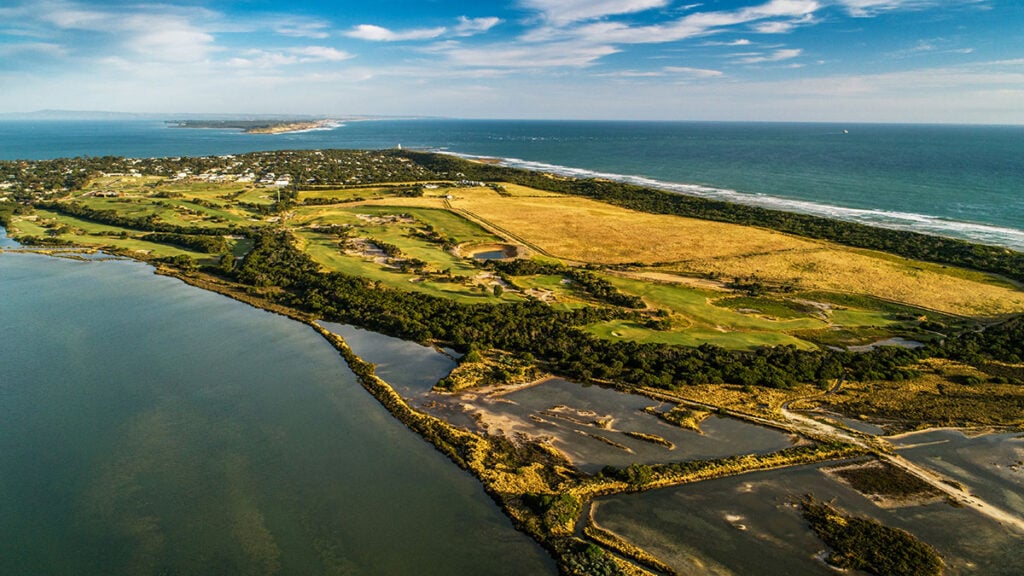Sometimes, when a new idea seems baffling, it’s helpful to silence the part of your brain that screams bloody murder and attempt to understand the idea on its own terms. At a minimum, this gives you a solid sense of the proponent’s reasoning when it’s time to argue against him, and in rare cases you might surprise yourself and have a change of heart. So when I read the headlines, “PGA of America mulling staging Ryder Cup without fans, CEO says,” over at ESPN, or “Ryder Cup exploring a spectator-less event, says PGA of America CEO” here at Australian Golf Digest, I tried to do just that. It was tempting to immediately head to Twitter, bang the metaphorical pots and pans, and shout two points into the digital ether:
1. The fans make the Ryder Cup, and the concept of holding it without them – of watching Ian Poulter or Justin Thomas hole a critical putt, only to be greeted by the faint whistle of the winds whipping in off Lake Michigan – is unthinkable. It would diminish the event, lower the stakes, and be bad for the institution itself in the long run. Much worse, by far, than simply delaying by a year. Even the players who would benefit the most from a quiet course are in agreement. Rory McIlroy is saying it, for god’s sake, and this is a guy who was famously abused, sometimes in heinous terms, the last time the Cup was in the United States. He would rather be screamed at by hordes of drunken midwesterners if it meant upholding the spirit of the event.
2. Wouldn’t this cost everyone money? I’ve been to Whistling Straits three times this Ryder Cup season, and the amount of work going into the event already is staggeringly expensive and very fan-dependent. I’m sure a year-long delay wouldn’t be great from a money perspective, but it surely has to be better than just tossing all that revenue away, right? (Through a representative, the PGA of America declined to comment about any insurance coverage they have for the Ryder Cup, or whether it would apply in the case of holding the event without fans.)
Instead of giving in to these first impulses, I tried to fathom the other side …
… and I couldn’t. There’s just no argument that holds water.

Now, let’s put this in perspective: The PGA of America is absolutely not committing to a Ryder Cup without fans, and the words “mulling” and “exploring” do a lot of work in the headlines above. In reality, it’s difficult to tell how deeply this has been/is being considered. It’s completely understandable for someone to broach the topic in a meeting, but there’s a massive gap between throwing ideas onto the metaphorical dartboard and actually getting to a point where implementation is a reality. The pertinent quotes bolstering the story come from Seth Waugh, PGA of America CEO, in an appearance with Ann Liguori on WFAN radio in New York, and it all feels very speculative. As Joel Beall wrote on Monday, Waugh understands the central dilemma:
Talking on Sunday to New York’s WFAN, Waugh said while “it’s hard to imagine one without fans” and that “the fans are the Ryder Cup, to a certain degree” he acknowledged his organisation is discussing that prospect for the biennial match, set to visit Wisconsin in late September.
“We have begun to talk about whether you could create some virtual fan experience, and we’re going to try to be as creative as we can,” Waugh told WFAN. “It’s [still] to be determined, frankly, whether you could hold it without fans or not.”
Waugh went on to say that fans are “particularly important” at the Ryder Cup in comparison to other events, even Majors, so we can rest easy knowing that he gets it, and the organisation is still very much in the just-asking-questions phase. In other words, no need to panic.
Still, organisations look at fan and media reaction as a barometer for trial balloons like this one, so let me add my voice to the choir: Please, please, please, PGA of America, don’t stage a Ryder Cup without fans. Every solution needs to be explored, we get that, but this exploration should be short and swift, and end with a definitive “no way in hell.”
The Ryder Cup was more or less a dud for decades upon decades, and the reason it changed can be summarised in two words: expansion and passion. The expansion brought continental Europe into the fold in 1979 and levelled the playing field in a way that would pay dividends by 1983, the first really competitive Ryder Cup of the modern era. But expansion alone wasn’t enough – it required buy-in from the players. Luckily for Europe, they had men like Tony Jacklin and Seve Ballesteros and Bernhard Langer and so many others who loved the Ryder Cup and wanted badly to prove themselves against the previously dominant Americans. That passion eventually translated to a continental fan base, and despite the geographic boundaries separating the European nations, a team identity emerged, and with it a fan identity.

As the matches became closer, and Europe began to win more than they lost, the event garnered more intrigue in America, too, and their own player passion and fan base grew. As the dynamic turned increasingly competitive, the tension skyrocketed, and fans responded by ratcheting up their fervour. Today, 40 years after the Ryder Cup re-invented itself so successfully, you simply cannot separate the event from the atmosphere. The songs, the roars and the general bedlam is symbiotic with the action on the course. They feed off each other in an act of pure energy escalation, and to remove one half of that formula is to neuter the entire spectacle.
Ask yourself this: Without fans, who would Patrick Reed shush? Who would Rory antagonise, one hand framing his ear, after sinking a massive putt? Would a darling duo like Moli-wood become instantly legendary or be just a cute couple?
More than any other event, the spirit of the Ryder Cup is defined by the fans. It needs the fans, full stop. The Masters wouldn’t be quite as good without, um, patrons, and ditto for every other tournament on the planet, but they would still be meaningful and entertaining. That’s just not true for the Ryder Cup. If the players gather at Whistling Straits in September, joined only by their families and a small gaggle of media and officials, it will be a pale imitation of the real thing. Better by far to delay, even by a year, than to stage the golf equivalent of a faint, flickering shadow.




